The Drug Device Combination Products Market is estimated to be valued at USD 155.7 billion in 2025 and is projected to reach USD 330.0 billion by 2035, registering a compound annual growth rate (CAGR) of 7.8% over the forecast period.
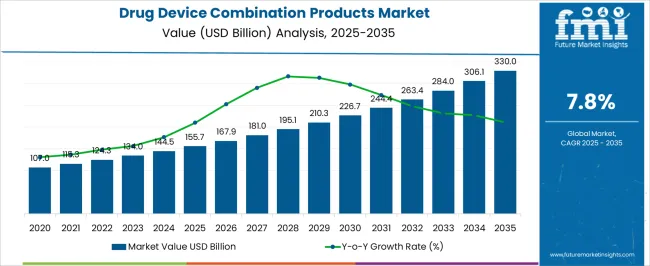
| Metric | Value |
|---|---|
| Drug Device Combination Products Market Estimated Value in (2025 E) | USD 155.7 billion |
| Drug Device Combination Products Market Forecast Value in (2035 F) | USD 330.0 billion |
| Forecast CAGR (2025 to 2035) | 7.8% |
The Drug Device Combination Products market is gaining strong traction due to its ability to merge pharmaceutical efficacy with medical device precision, enabling improved therapeutic outcomes across a wide range of clinical applications. These products are increasingly being adopted in areas such as cardiovascular care, oncology, diabetes management, and respiratory therapy, where conventional drugs or devices alone often fail to deliver optimal results. Advances in nanotechnology, drug delivery systems, and minimally invasive procedures are fueling innovation in this field, offering patients more targeted and effective treatment options.
Rising incidences of chronic diseases, an aging global population, and growing demand for personalized medicine are major factors supporting market expansion. Regulatory bodies are also developing clearer pathways for approval, thereby encouraging more companies to invest in research and development.
The growing emphasis on safety, efficacy, and patient compliance is further shaping adoption trends As healthcare providers prioritize integrated solutions that reduce complications and improve clinical efficiency, the Drug Device Combination Products market is expected to register sustained growth over the forecast period.
The drug device combination products market is segmented by product type, end user, and geographic regions. By product type, drug device combination products market is divided into Drug Eluting Stents, Peripheral Vascular Stents, Coronary Stents, Infusion Pumps, Implantable Infusion Pumps, Ambulatory Infusion Pumps, Orthopedic Combination Products, Wound Care Combination Products, Inhalers & Nebulizers, Dry Powder Inhalers, Metered Dose Inhalers, Nebulizers, Ultrasonic Nebulizers, Compressor Nebulizers, Mesh Nebulizers, Transdermal Patches, and Other Products. In terms of end user, drug device combination products market is classified into Hospitals & Clinics, Emergency Service Centers, Ambulatory Surgical Centers, and Home Care Settings. Regionally, the drug device combination products industry is classified into North America, Latin America, Western Europe, Eastern Europe, Balkan & Baltic Countries, Russia & Belarus, Central Asia, East Asia, South Asia & Pacific, and the Middle East & Africa.
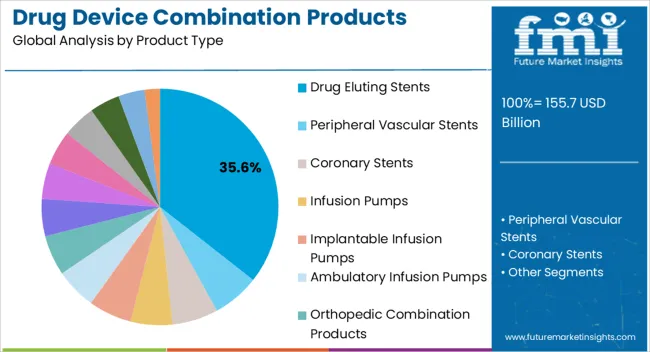
The drug eluting stents segment is expected to hold 35.6% of the market revenue in 2025, making it the leading product type. Growth in this segment is largely attributed to the rising prevalence of cardiovascular diseases and the increasing adoption of minimally invasive procedures for treating coronary artery blockages. Drug eluting stents are designed to release medication over time, reducing the likelihood of restenosis while maintaining arterial patency, which significantly improves patient outcomes.
Continuous advancements in stent design, such as biodegradable coatings and enhanced drug formulations, are further supporting widespread use. The clinical benefits of reduced repeat procedures, lower complication risks, and improved recovery rates have strengthened the preference for drug eluting stents among healthcare providers.
Strong adoption is also being driven by favorable reimbursement policies and rising healthcare investments in advanced cardiac care As demand for efficient cardiovascular solutions continues to grow, drug eluting stents are expected to maintain their dominance, supported by ongoing innovation and expanding accessibility in both developed and emerging healthcare systems.
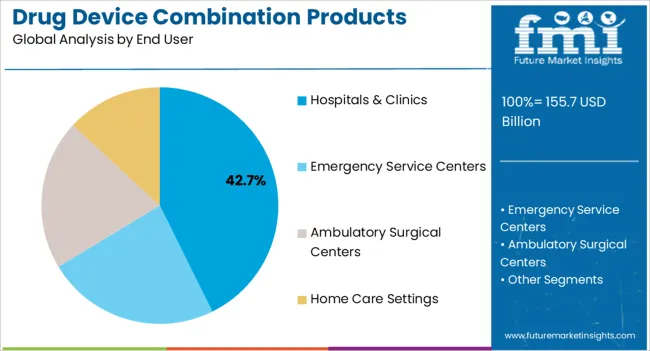
The hospitals and clinics segment is projected to account for 42.7% of the market revenue in 2025, establishing it as the leading end user. The segment’s dominance is being driven by the fact that hospitals and clinics serve as the primary centers for advanced medical procedures, patient monitoring, and post-treatment care, where drug device combination products are most frequently utilized. Growing cases of chronic conditions, particularly cardiovascular and oncological diseases, are increasing the demand for integrated therapies administered in these settings.
Hospitals and clinics are increasingly adopting drug device combination products to reduce complications, shorten recovery times, and enhance patient outcomes. Moreover, the availability of specialized healthcare professionals, advanced surgical infrastructure, and comprehensive treatment facilities has reinforced their role as the key end users in this market.
The segment is also benefiting from increasing healthcare expenditures, expanding hospital networks in emerging economies, and rising patient inflows With greater emphasis on quality care, regulatory compliance, and cost-effective treatments, hospitals and clinics are expected to remain the primary drivers of adoption in the Drug Device Combination Products market.
Drug device combination products are devices which consists medical device along with the pharmaceutical ingredient that helps to deliver the drug to desired location in the patient’s body. These combination products have emerged as innovative medical devices owing to the contribution in advancing medical care and are thus expected to have major impact in the coming years.
Drug device combination products product includes inhalers, drug eluting stents, and wound care products among others. The advantages offered by drug device combination products include minimal side effects, controlled drug administration, improved patient compliance, and targeted drug delivery.
Owing to its wide range of advantages and increased sophistication, these devices have been widely adopted across the medical industry.
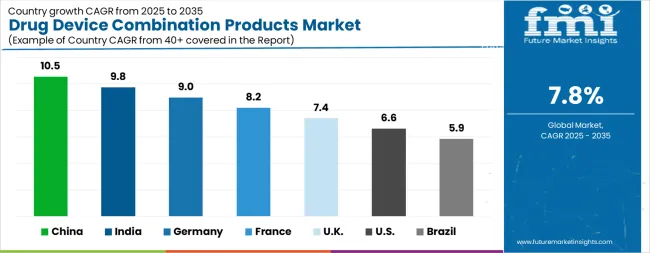
| Country | CAGR |
|---|---|
| China | 10.5% |
| India | 9.8% |
| Germany | 9.0% |
| France | 8.2% |
| UK | 7.4% |
| USA | 6.6% |
| Brazil | 5.9% |
The Drug Device Combination Products Market is expected to register a CAGR of 7.8% during the forecast period, exhibiting varied country level momentum. China leads with the highest CAGR of 10.5%, followed by India at 9.8%. Developed markets such as Germany, France, and the UK continue to expand steadily, while the USA is likely to grow at consistent rates. Brazil posts the lowest CAGR at 5.9%, yet still underscores a broadly positive trajectory for the global Drug Device Combination Products Market. In 2024, Germany held a dominant revenue in the Western Europe market and is expected to grow with a CAGR of 9.0%. The USA Drug Device Combination Products Market is estimated to be valued at USD 57.2 billion in 2025 and is anticipated to reach a valuation of USD 108.7 billion by 2035. Sales are projected to rise at a CAGR of 6.6% over the forecast period between 2025 and 2035. While Japan and South Korea markets are estimated to be valued at USD 8.5 billion and USD 4.9 billion respectively in 2025.
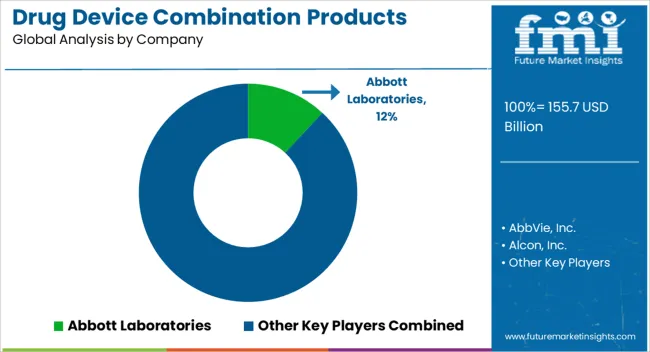
| Item | Value |
|---|---|
| Quantitative Units | USD 155.7 Billion |
| Product Type | Drug Eluting Stents, Peripheral Vascular Stents, Coronary Stents, Infusion Pumps, Implantable Infusion Pumps, Ambulatory Infusion Pumps, Orthopedic Combination Products, Wound Care Combination Products, Inhalers & Nebulizers, Dry Powder Inhalers, Metered Dose Inhalers, Nebulizers, Ultrasonic Nebulizers, Compressor Nebulizers, Mesh Nebulizers, Transdermal Patches, and Other Products |
| End User | Hospitals & Clinics, Emergency Service Centers, Ambulatory Surgical Centers, and Home Care Settings |
| Regions Covered | North America, Europe, Asia-Pacific, Latin America, Middle East & Africa |
| Country Covered | United States, Canada, Germany, France, United Kingdom, China, Japan, India, Brazil, South Africa |
| Key Companies Profiled | Abbott Laboratories, AbbVie, Inc., Alcon, Inc., Bausch Health Companies Inc, Baxter International Inc., Bayer AG, Becton, Dickinson and Company, Boston Scientific Corporation, GlaxoSmithKline plc, Johnson & Johnson, Kaleo, Inc., Medtronic plc, Novartis AG, SINOMED, Smith & Nephew plc, Teleflex Incorporated, and Teva Pharmaceutical Industries Ltd. |
The global drug device combination products market is estimated to be valued at USD 155.7 billion in 2025.
The market size for the drug device combination products market is projected to reach USD 330.0 billion by 2035.
The drug device combination products market is expected to grow at a 7.8% CAGR between 2025 and 2035.
The key product types in drug device combination products market are drug eluting stents, peripheral vascular stents, coronary stents, infusion pumps, implantable infusion pumps, ambulatory infusion pumps, orthopedic combination products, wound care combination products, inhalers & nebulizers, dry powder inhalers, metered dose inhalers, nebulizers, ultrasonic nebulizers, compressor nebulizers, mesh nebulizers, transdermal patches and other products.
In terms of end user, hospitals & clinics segment to command 42.7% share in the drug device combination products market in 2025.






Our Research Products

The "Full Research Suite" delivers actionable market intel, deep dives on markets or technologies, so clients act faster, cut risk, and unlock growth.

The Leaderboard benchmarks and ranks top vendors, classifying them as Established Leaders, Leading Challengers, or Disruptors & Challengers.

Locates where complements amplify value and substitutes erode it, forecasting net impact by horizon

We deliver granular, decision-grade intel: market sizing, 5-year forecasts, pricing, adoption, usage, revenue, and operational KPIs—plus competitor tracking, regulation, and value chains—across 60 countries broadly.

Spot the shifts before they hit your P&L. We track inflection points, adoption curves, pricing moves, and ecosystem plays to show where demand is heading, why it is changing, and what to do next across high-growth markets and disruptive tech

Real-time reads of user behavior. We track shifting priorities, perceptions of today’s and next-gen services, and provider experience, then pace how fast tech moves from trial to adoption, blending buyer, consumer, and channel inputs with social signals (#WhySwitch, #UX).

Partner with our analyst team to build a custom report designed around your business priorities. From analysing market trends to assessing competitors or crafting bespoke datasets, we tailor insights to your needs.
Supplier Intelligence
Discovery & Profiling
Capacity & Footprint
Performance & Risk
Compliance & Governance
Commercial Readiness
Who Supplies Whom
Scorecards & Shortlists
Playbooks & Docs
Category Intelligence
Definition & Scope
Demand & Use Cases
Cost Drivers
Market Structure
Supply Chain Map
Trade & Policy
Operating Norms
Deliverables
Buyer Intelligence
Account Basics
Spend & Scope
Procurement Model
Vendor Requirements
Terms & Policies
Entry Strategy
Pain Points & Triggers
Outputs
Pricing Analysis
Benchmarks
Trends
Should-Cost
Indexation
Landed Cost
Commercial Terms
Deliverables
Brand Analysis
Positioning & Value Prop
Share & Presence
Customer Evidence
Go-to-Market
Digital & Reputation
Compliance & Trust
KPIs & Gaps
Outputs
Full Research Suite comprises of:
Market outlook & trends analysis
Interviews & case studies
Strategic recommendations
Vendor profiles & capabilities analysis
5-year forecasts
8 regions and 60+ country-level data splits
Market segment data splits
12 months of continuous data updates
DELIVERED AS:
PDF EXCEL ONLINE
Multi-Drug/Combination Injectable Market Forecast and Outlook 2025 to 2035
Road Side Drug Testing Devices Market
Connected Drug Delivery Devices Market Size and Share Forecast Outlook 2025 to 2035
Implantable Drug Eluting Devices Market Size and Share Forecast Outlook 2025 to 2035
Counterfeit Drug Detection Device Market Size and Share Forecast Outlook 2025 to 2035
Market Share Insights for Subcutaneous Drug Delivery Devices Providers
IV Fluid Transfer Drugs Devices Market Trends – Growth & Forecast 2025 to 2035
Drug Taste Masking Technologies Market Forecast and Outlook 2025 to 2035
Drug-Gene Interaction Panels Market Size and Share Forecast Outlook 2025 to 2035
Drug Testing Systems Market Size and Share Forecast Outlook 2025 to 2035
Drug Tester Market Size and Share Forecast Outlook 2025 to 2035
Drug Discovery Enzymes Market Size and Share Forecast Outlook 2025 to 2035
Combination Kinase Inhibitor Market Analysis - Size, Share, and Forecast Outlook 2025 to 2035
Combination Antihypertensive Agents Market Analysis - Size, Share, and Forecast Outlook 2025 to 2035
Drug Integrated Polymer Fibers Market Size and Share Forecast Outlook 2025 to 2035
Drug Discovery Outsourcing Market Size and Share Forecast Outlook 2025 to 2035
Products from Food Waste Industry Analysis in Korea Size, Share and Forecast Outlook 2025 to 2035
Products from Food Waste in Japan - Size, Share, and Forecast Outlook 2025 to 2035
Drug Formulation Market Analysis - Size, Growth, & Forecast Outlook 2025 to 2035
Combination Spanner Set Market Size and Share Forecast Outlook 2025 to 2035

Thank you!
You will receive an email from our Business Development Manager. Please be sure to check your SPAM/JUNK folder too.
Chat With
MaRIA